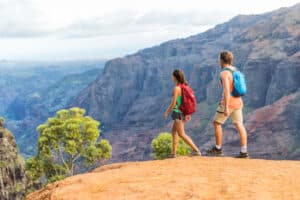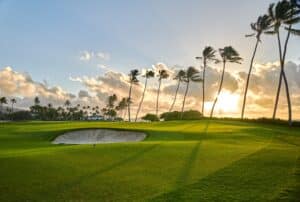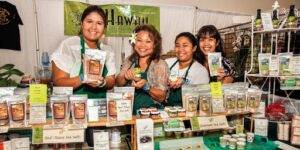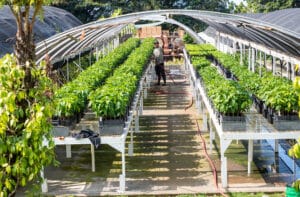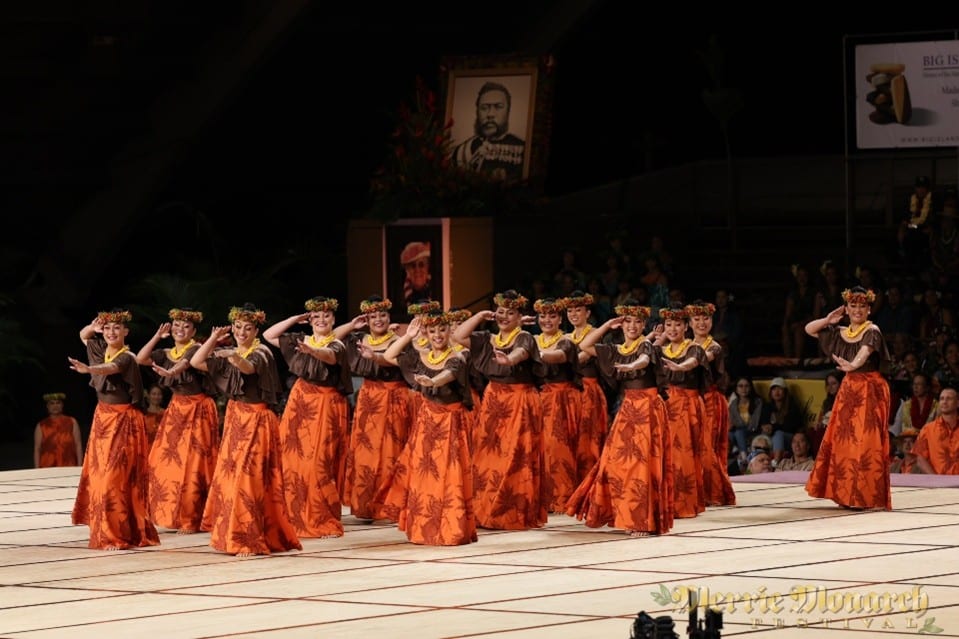
Hālau Hula Ka Lehua Tuahine – Kumu Hula Ka‘ilihiwa Vaughan-Darval (Photo Credit: Tracey Niimi)
Held annually on Hawai‘i Island, the Merrie Monarch Festival in Hilo is the largest and most prestigious celebration of hula in the world. This year, the week-long festival runs from April 20–26, 2025, beginning as always, on Easter Sunday.
Now in its seventh decade, the festival is more than a hula competition — it’s a powerful symbol of Hawaiian culture and pride. I’m lucky enough to live in Hilo, where excitement builds months in advance for the highly anticipated event.
Created to revive interest in hula and the Hawaiian language, what started as a small community gathering grew into an internationally acclaimed spectacle, drawing thousands of visitors and viewers from around the world. The Merrie Monarch Festival is now the Big Island’s largest annual event, with televised coverage and live streams bringing the spirit of hula to a global audience.
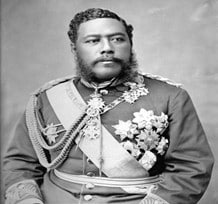
King David Kalakaua (Photo Credit: Hawaii State Archives)
King Kalākaua, the Merrie Monarch
The Merrie Monarch Festival honors King David Kalākaua, who played a crucial role in preserving Hawaiian traditions in the late 19th century. Nicknamed the “Merrie Monarch” for his love of music, hula, and the performing arts, Kalākaua led a cultural revival during a time when Hawaiian customs were being suppressed by Western influence.
Christian missionaries disapproved of dance, considering it inappropriate. In defiance, Kalākaua championed the restoration of traditional practices like chanting and hula. He hosted grand celebrations at ‘Iolani Palace, where Hawaiians were encouraged to embrace their heritage with pride.
Kalākaua famously said, “Hula is the language of the heart, therefore the heartbeat of Hawaiian people.”
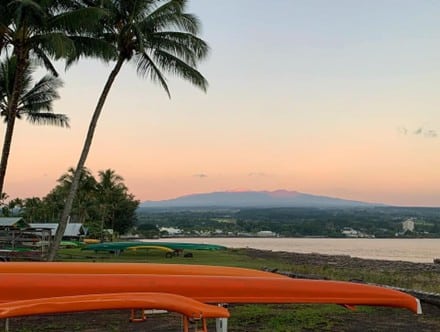
Canoes waiting for the next races on Hilo Bay (Photo Credit: Hawaiianscribe)
The Setting of the Festival: Hilo Town
Tucked along the lush East Coast of Hawai‘i Island, Hilo is a charming town that comes alive every spring for the Merrie Monarch Festival. Fed by abundant rain, the town is surrounded by green parks, tropical gardens, and waterfalls — the perfect backdrop for a celebration of hula and Hawaiian culture.
Nestled at the base of Mauna Kea, the tallest mountain in Hawai‘i, Hilo’s population nearly doubles during festival week. Locals take time off — what we lovingly call “playing tourist” — to fully embrace the events. Hotels host lunchtime hula performances, downtown shops bustle with festival-goers, and arts and crafts fairs showcase everything from handmade leis to locally crafted jewelry.
For those visiting, Hilo is also the gateway to Hawai‘i Volcanoes National Park, a scenic 40-minute drive away. The park is home to Kīlauea, one of the world’s most active volcanoes, adding a dramatic natural element to your cultural journey.
During Merrie Monarch Week, the air is filled with the scent of plumeria, tuberose, puakenikeni, maile, ‘ilima, orchid, ginger, and ‘ōhi‘a lehua — woven into leis and worn by nearly everyone. It’s a week of beauty, tradition, and deep aloha.
To learn more about what to do while you’re in town, visit the Hilo Downtown Improvement Association or Destination Hilo.
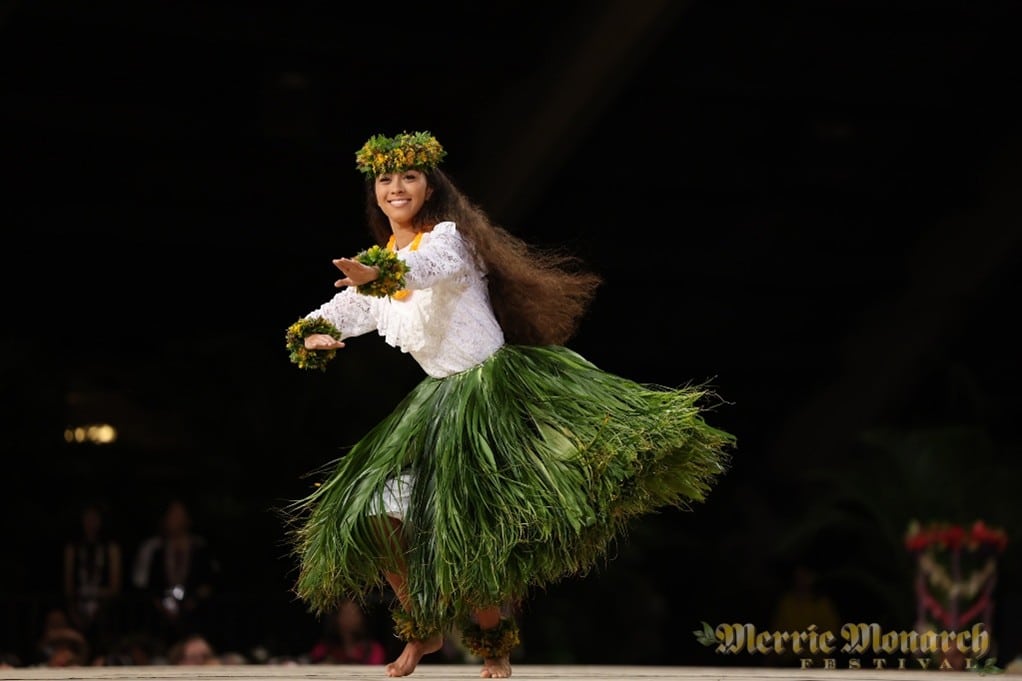
Amedée Kauakohemālamalama Conley-Kapoi – Hālau Kekuaokalā‘au‘ala‘iliahi – Nā Kumu Hula Haunani & ‘Iliahi Paredes (Photo Credit: Cody Yamaguchi)
The Heart of the Festival: Hula as Storytelling
Hula is more than just a dance — it’s a sacred art form that tells the stories of Hawai‘i’s people, places, genealogy, mythology, and values. To perform at Merrie Monarch, dancers often train for years in a hula hālau (hula school), refining their body, mind, and spirit through disciplined practice.
At the center of each hālau is the kumu hula, the teacher and cultural steward who passes down the traditions of hula. The Merrie Monarch Festival honors the work of these kumu, spotlighting their knowledge, mentorship, and dedication to the craft. The bond between the kumu and the student is rooted in trust, tradition, and mutual respect — on full display during every performance.
This isn’t Hollywood hula. It’s the most authentic hula you’ll find anywhere. To preserve that authenticity, the festival relies on a panel of judges, most of whom are experienced kumu hula themselves. Selected for their expertise in Hawaiian culture and language, they sit at the edge of the stage, close enough to observe every gesture, chant, and movement. Scorecards are collected after each hālau performs, and not even the judges know the final results until the awards are announced on the last night.
To learn more about hula, visit the Hula Preservation Society.
Festival Schedule
The Merrie Monarch Festival is a week-long celebration of Hawaiian culture featuring hula competitions, exhibitions, craft fairs, and a vibrant community parade.
Cultural Demonstrations & Craft Fairs (All Week)
Explore Hawaiian artistry through kapa (bark cloth), lauhala weaving, featherwork, and lei making. Artisans display and sell their handmade crafts throughout Hilo, creating a festive atmosphere around every corner.
Sunday, April 20 – Hoʻolauleʻa (Opening Celebration)
Afook-Chinen Civic Auditorium
9 a.m.
Free admission to performances by local Big Island hālau (hula schools). A lively kickoff to festival week.
Monday, April 21 through Friday, April 25 – Free Midday Entertainment
Grand Naniloa Hotel – 12 p.m.
Hilo Hawaiian Hotel – 1 p.m.
Enjoy daily live music and hula by local performers.
Merrie Monarch Invitational Hawaiian Arts Fair
Afook-Chinen Civic Auditorium
Wednesday–Friday (April 23–25): 9 a.m. – 5 p.m.
Saturday, April 26: 9 a.m. – 4 p.m.
This free event is a fan favorite, featuring local artists, crafters, and live entertainment. Be sure to check out the collectible Merrie Monarch merchandise.
Wednesday, April 23 – Hōʻike Night (Exhibition Night)
Edith Kanaka‘ole Stadium
6 p.m.
An evening of non-competitive hula and Pacific Island dance, free and open to the public — no tickets required. Locals line up early, and the food vendors stay busy with laulau, poi, chili and rice, and spam musubi.
Thursday, April 24 – Miss Aloha Hula Competition
Edith Kanaka‘ole Stadium
6 p.m.
This prestigious solo competition showcases the top female dancers from each hālau. Contestants perform hula kahiko, hula ‘auana, and oli (chant). The title of Miss Aloha Hula is one of hula’s highest honors. The competition is televised across Hawai‘i, and many winners go on to become kumu hula themselves.
Friday, April 25 – Group Hula Kahiko Competition
Edith Kanaka‘ole Stadium
6 p.m.
This is the heart of the Merrie Monarch Festival. Hālau from across Hawai‘i and beyond perform hula kahiko, the ancient style of hula featuring traditional attire, chants, and percussion instruments. These performances are powerful and precise, rooted deeply in Hawaiian history and spirituality.
Saturday, April 26 – Merrie Monarch Royal Parade
Historic Downtown Hilo
10:30 a.m.
A beloved, family-friendly tradition, the Merrie Monarch Royal Parade features marching bands, cultural groups, entertainers, and a Royal Court portraying King Kalākaua and Queen Kapiʻolani. You’ll also see the newly crowned Miss Aloha Hula and the stunning pāʻū riders — women on horseback in flowing satin gowns, with horses adorned in lei and traditional dress.
Saturday, April 26 – Group Hula ‘Auana Competition & Awards Ceremony
Edith Kanaka‘ole Stadium
6 p.m.
Hālau returns to the stage for hula ‘auana, the modern form of hula known for its fluid, expressive movements and melodic songs. After the final performance, the awards are announced — culminating a year (or more) of preparation. Dancers are judged on interpretation, precision, posture, and overall presentation. The competition is intense and deeply respected.
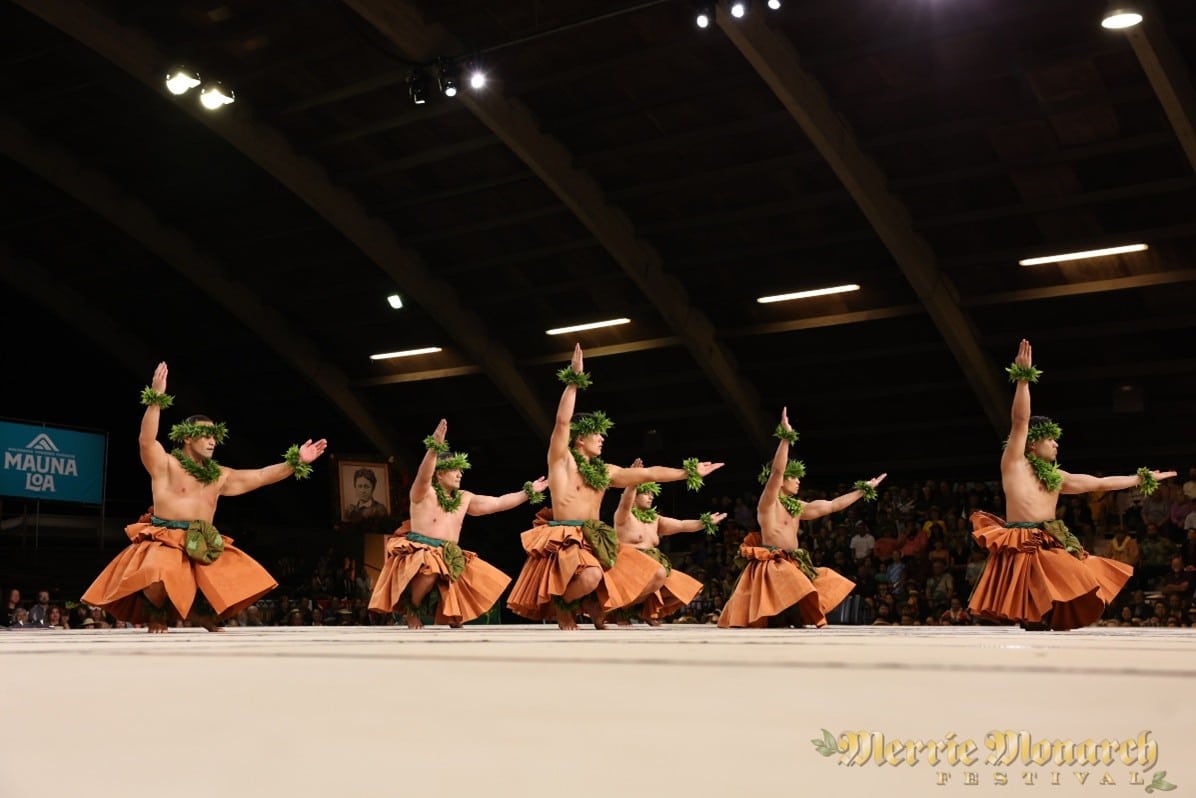
Ke Kai o Kahiki – Kumu Hula La‘akea Perry – Kāne) (Photo Credit: Bruce Omori)
Hula Kahiko and Hula ‘Auana Group Competitions
The heart of the Merrie Monarch Festival lies in the group hula competitions. Male and female groups perform in two categories:
- Hula Kahiko: The ancient style of hula with dancers wearing traditional attire, performing chants, and using percussion instruments. The movements are powerful, precise, and deeply rooted in history.
- Hula ‘Auana: The modern style of hula incorporates Hawaiian melodies and contemporary influences. The performances are graceful, fluid, and emotionally expressive.
The dancers are judged on interpretation, precision, posture, and overall presentation. The competition is intense, with hālau spending months, sometimes years, preparing for this prestigious event.
Tickets to the Merrie Monarch Festival
Planning ahead is key — tickets are only sold by mail each December for the following year’s festival. A few weeks before the sale begins, an announcement is posted on the Merrie Monarch website. Requests must include payment the old-fashioned way, by money order or cashier’s check, and postmarks are strictly enforced. If your envelope is postmarked too early, it will be returned.
Seating is limited — Edith Kanaka‘ole Stadium holds just about 5,000 people, and demand is high. Still, the festival remains accessible, with tickets priced at just $40 for all three nights of competition.
Can’t make it in person? You can still experience the magic with free live streaming on the Merrie Monarch website during the competition.
The Global Reach of Hula
The Merrie Monarch Festival has been instrumental in the revival of Hawaiian culture and identity. It has helped restore the authenticity of hula, reaffirming its sacred, historical roots. Perhaps most importantly, the festival has inspired a new generation of Hawaiians to embrace their heritage, learn the Hawaiian language, and carry these traditions forward.
Today, Hawaiian kumu hula lead hālau not just in Hawai‘i, but across the mainland U.S. and internationally in countries like Japan, Canada, and Mexico. Thanks to Merrie Monarch’s influence, hula has become a global expression of aloha — connecting people worldwide to the stories, values, and beauty of Hawaiian culture.
